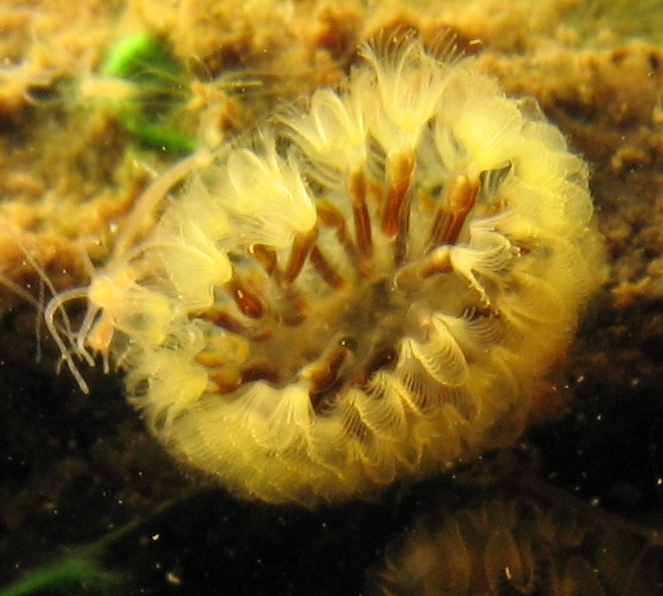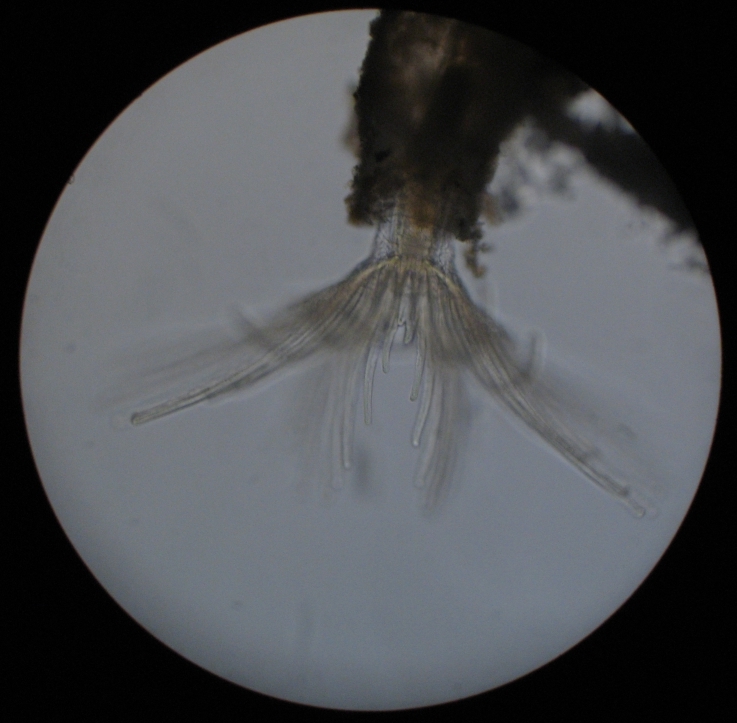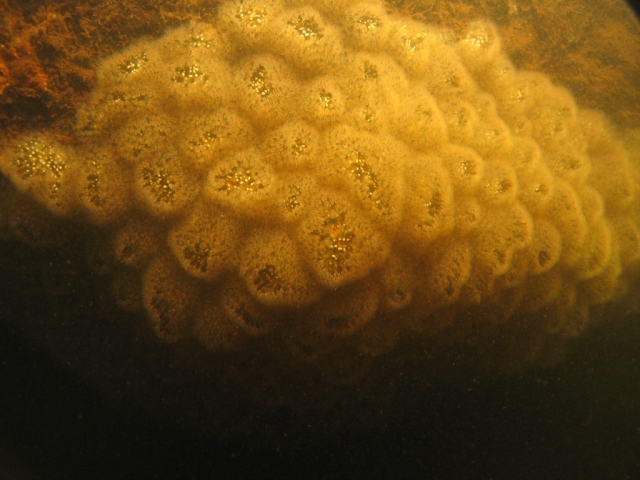
Cristatella mucedo (smallish colony) - photographed in situ
by Michiel van der Waaij, The Netherlands
There is a group of smallish aquatic invertebrates that live a well hidden life in lakes, ponds and small streams. Once discovered they are delightful and surprisingly complex. I first encountered them about 6 years ago while scuba diving in a local lake. This group is called the bryozo (bryozoans or bryozoa) or moss animal(s). Some (older) American literature refers to them as Polyzoa.

Cristatella mucedo (smallish colony) - photographed in situ
There are 11 to 15 species of bryozoans that live in European freshwater and more than one hundred can be found in the seas surrounding Europe. In the Netherlands I found eleven species so far and I am searching for two more.
Bryozoans live in colonies as can be seen in the picture above. Each individual or zooid works day and night to capture food by creating a water current towards its mouth with cilia (whip hairs) that are located on each tentacle. From there it passes through a complete gut system.
The tentacle crown or lophophore can be rapidly retracted in case of disturbance. The lophophore is also continuously moved around in the hope of attracting more food.
Besides a gut system they have several muscles for manipulating the lophophore, a nerve knot and reproductive organs. They do not breathe as they are small enough to obtain oxygen and shed carbon through diffusion.
Seawater colonies show specialization, where some zooids perform a specialist role. This is not seen in
freshwater species.

Plumatella fruticosa
Bryozoans live a short life. Generally around 6 weeks to a few months. I find them in late spring (May - June) and early fall (September - October). In winter it is too cold, in Summer too warm for many species. Some colonies may live through summer though and some species (Pectinatella magnifica) needs warmth so is predominantly available in summer. Other species (Lophopus crystallinus) wants it to be cold and can be found in winter or in deeper colder water.
The reason they live a hidden life, besides being smallish (up to a few centimeter for a colony), is that they are easily swamped by larger particles falling on them. So they hide below rocks, sticks or aquatic plants. They also cannot handle wave action so generally I find them below 0.5 - 1 meter.
Freshwater bryozoans have a threefold approach to reproduction:
|
|
|
Besides the gelatinous colonies shown above there are also colonies that are more bushy in shape. Some are free hanging/standing and grow by forming branches, such as Fredericella sultana and Plumatella fruticosa. Some stay closer to the substrate, like Plumatella repens (not shown) and some form tightly packed colonies, such as Plumatella fungosa (also not shown).
|
|
|
One day after a tip I went scuba diving in a local stream with about 40 cm visibility and found the first occurrence of Pectinatella magnifica in the Netherlands. This is a rare species that is most likely imported from the United States. This is a species that grows into large if not massive colonies (two meters diameter in Japan). This colony was not that large, about 30 x 40 cm. The white dots are zooids that have retracted their lophophore
as I came too close.
It was a real thrill for me to be the first to observe them in the Netherlands!

Plumatella magnifica - photographed in situ
As you probably understood by now I am hooked on these tiny animals. Underwater I have developed an eye for them so I find up to 5 species in an one hour dive (given the right location). I also collect and study literature and maintain a website (see link below).
Observing them under a microscope added a whole new dimension to the pleasure I get by studying them and greatly enhanced my understanding.
Underwater macrophotography is a really challenging activity. First of all as a scuba diver you float going up and down with each breath you take and possibly you are pulled at by a current, so there is no stable point of reference. Secondly the visibility is bad, ranging from a few meters to 30-40 centimeters. Thirdly there is the silt. One move that is too rapid and the whole image is filled with particles that reflect the light from the flash. Then
there is the color issue - many lakes in my region have a partial peat bottom or are fed by streams going through peat regions, so the water is always slightly yellow in color. As bryozoans hate silt, they are hidden, so the camera has to be pressed into crevices or I have to float upside down to make pictures of the underside of tree stumps that are partially submerged.
So all the conditions you can control on land are not really in control. This of course is on top of the normal macrophotography challenges with very limited depth of field and very close distance to object. Many bryozoans do not really appreciate a camera being almost pressed into them and rapidly retract their lophophore.
The solution: lots of practice, lots of patience and lots of pictures, most of which are discarded.
For those who are interested, I use a Canon PowerShot A640 with underwater housing and a Ikelite DS50 or DS125 underwater flash. I chose the A640 for its extreme macro ability - close-up to 1 cm. This is further enhanced by the fact that the water / glass / air borders of the underwater housing enlarge about 30%.
Comments to the author
Michiel van der Waaij are welcomed.
All photos are my own and are made in situ or through a microscope on my bench (Zeiss standard with a Canon PowerShot digital compact camera). Copyright (c) 2009 Michiel van der Waaij - all rights reserved.
Published in the July
2009 edition of Micscape.
Please report any Web problems or
offer general comments to the Micscape
Editor.
Micscape is the on-line monthly magazine
of the Microscopy UK web
site at Microscopy-UK